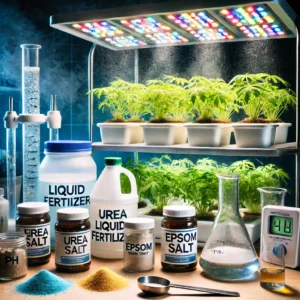
Aeroponics is a highly efficient method of growing plants without soil, where roots are suspended in the air and misted with a nutrient-rich solution.
Providing the right nutrients is crucial to ensure the health and productivity of your plants.
While commercial liquid fertilizers are readily available, making your own aeroponic liquid fertilizer at home can be cost-effective and allows for customization based on your plants’ needs.
In this article, we’ll explore how to make aeroponic liquid fertilizer at home and the benefits of doing so.
Understanding the Nutrient Needs of Aeroponic Plants
Before diving into making your own liquid fertilizer, it’s important to understand the essential nutrients that aeroponic plants require.
These nutrients can be categorized into macronutrients and micronutrients.
Macronutrients
Nitrogen (N) is essential for leaf growth and overall plant development.
Phosphorus (P) is important for root development and flowering, while potassium (K) helps with overall plant health, disease resistance, and fruit quality.
Secondary Macronutrients
Calcium (Ca) is important for cell wall structure and strength.
Magnesium (Mg) is a central component of chlorophyll necessary for photosynthesis, and sulfur (S) is important for protein synthesis and enzyme function.
Micronutrients
Micronutrients needed in smaller quantities include iron (Fe), manganese (Mn), zinc (Zn), copper (Cu), boron (B), and molybdenum (Mo).
These nutrients are still essential for plant health.
Benefits of Making Your Own Aeroponic Liquid Fertilizer
Creating your own liquid fertilizer at home offers several advantages. It can be cost-effective compared to purchasing commercial options.
Additionally, it allows for customization to tailor the nutrient mix to the specific needs of your plants.
By making your own fertilizer, you have control over the quality and purity of the ingredients used, which can result in more sustainable and environmentally friendly gardening practices.
Ingredients for Homemade Aeroponic Liquid Fertilizer
To make a balanced liquid fertilizer at home, you’ll need specific ingredients for each nutrient category.
For macronutrients, you can use urea or ammonium nitrate as a nitrogen source, monoammonium phosphate (MAP) or diammonium phosphate (DAP) for phosphorus, and potassium nitrate or potassium sulfate for potassium.
Secondary macronutrients can be sourced from calcium nitrate for calcium and nitrogen, and Epsom salt (magnesium sulfate) for magnesium and sulfur.
For micronutrients, you can use iron chelate for iron, manganese sulfate for manganese, zinc sulfate for zinc, copper sulfate for copper, boric acid for boron, and sodium molybdate for molybdenum.
Step-by-Step Guide to Making Aeroponic Liquid Fertilizer
Step 1: Prepare the Equipment
Gather all necessary equipment, including measuring spoons, a mixing container, and a pH meter.
Ensure all equipment is clean and sanitized to prevent contamination.
Step 2: Measure the Ingredients
Accurately measure the required amounts of each ingredient. Here’s a basic formula for a 1-gallon nutrient solution:
-
Nitrogen Source: 1 teaspoon of urea or ammonium nitrate
-
Phosphorus Source: 1/2 teaspoon of monoammonium phosphate (MAP)
-
Potassium Source: 1 teaspoon of potassium nitrate
-
Calcium Source: 1/2 teaspoon of calcium nitrate
-
Magnesium and Sulfur Source: 1 teaspoon of Epsom salt (magnesium sulfate)
-
Micronutrients:
-
-
1/4 teaspoon of iron chelate
-
1/8 teaspoon of manganese sulfate
-
1/8 teaspoon of zinc sulfate
-
1/16 teaspoon of copper sulfate
-
1/16 teaspoon of boric acid
-
A pinch of sodium molybdate
-
Step 3: Dissolve the Ingredients
Fill the mixing container with one gallon of distilled or filtered water.
Add each ingredient one at a time, stirring thoroughly to ensure complete dissolution.
Begin with the macronutrients, followed by the secondary macronutrients, and finally the micronutrients.
Step 4: Adjust the pH
After all ingredients are dissolved, check the pH of the solution using a pH meter.
The ideal pH range for most aeroponic plants is between 5.5 and 6.5. Use phosphoric acid to lower the pH or potassium hydroxide to raise it.
Add the pH adjuster drop by drop, stirring and testing frequently until the desired pH is achieved.
Step 5: Store and Use the Solution
Store the prepared nutrient solution in a clean, airtight container away from direct sunlight.
Label the container with the contents and date of preparation.
Use the solution in your aeroponic system as needed, monitoring plant health and adjusting the nutrient mix if necessary.
Tips for Successful Aeroponic Fertilizer Use
Monitoring plant health regularly is crucial for identifying signs of nutrient deficiencies or excesses, such as yellowing leaves, stunted growth, and poor fruit production.
Adjust the nutrient ratios based on plant growth stages, increasing phosphorus during flowering and fruiting stages.
Ensure your aeroponic system is maintained properly by regularly cleaning and sanitizing to prevent the buildup of algae, bacteria, and other contaminants.
Using high-quality water is essential, so consider a reliable water filtration system like those from NuAqua Systems.
Providing adequate lighting with high-quality grow lights such as those from GrowAce ensures your plants receive the necessary light spectrum and intensity for healthy growth.
Lastly, ensure proper aeration in your system by investing in a high-quality aeroponic system like the Lettuce Grow Farmstand.
Wrapping Up
Making your own aeroponic liquid fertilizer at home is a cost-effective and customizable way to ensure your plants receive the essential nutrients they need for optimal growth.
By understanding the nutrient requirements, using high-quality ingredients, and following proper preparation and application methods, you can create a balanced nutrient solution that promotes healthy, thriving plants.
Regularly monitor and adjust the nutrient solution based on plant needs, and maintain your aeroponic system for the best results.
With the right approach, you can achieve a productive and sustainable aeroponic garden.
Happy growing!
